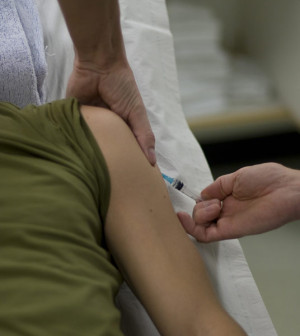- Skip Storing This Everyday Product in the Fridge Door
- Green Tea + B3 Pairing May Boost Brain Health
- Navigating Your Midlife Crisis: Embracing New Possibilities
- City Raccoons Showing Signs of Domestication
- Mapping the Exposome: Science Broadens Focus to Environmental Disease Triggers
- One Week Less on Social Media Linked to Better Mental Health
- Your Brain Changes in Stages as You Age, Study Finds
- Some Suicide Victims Show No Typical Warning Signs, Study Finds
- ByHeart Formula Faces Lawsuits After Babies Sickened With Botulism
- Switch to Vegan Diet Could Cut Your Greenhouse Gas Emissions in Half
Researchers Probe Why Colds Are More Likely in Winter


Though it’s never been scientifically confirmed, conventional wisdom has it that winter is the season of sniffles.
Now, new animal research seems to back up that idea. It suggests that as internal body temperatures fall after exposure to cold air, so too does the immune system’s ability to beat back the rhinovirus that causes the common cold.
“It has been long known that the rhinovirus replicates better at the cooler temperature, around 33 Celsius (91 Fahrenheit), compared to the core body temperature of 37 Celsius (99 Fahrenheit),” said study co-author Akiko Iwasaki, a professor of immunobiology at Yale University School of Medicine.
“[But] the reason for this cold temperature preference for virus replication was unknown. Much of the focus on this question has been on the virus itself. However, virus replication machinery itself works well at both temperatures, leaving the question unanswered,” Iwasaki said.
“We used mouse airway cells as a model to study this question [and found that] at the cooler temperature found in the nose, the host immune system was unable to induce defense signals to block virus replication,” Iwasaki explained.
The researchers discuss their findings in the current issue of the Proceedings of the National Academy of Sciences.
To explore the potential relationship between internal body temperatures and the ability to fend off a virus, the research team incubated mouse cells in two different temperature settings. One group of cells was incubated at 37 C (99 F) to mimic the core temperature found in the lungs, and the other at 33 C (91 F) to mimic the temperature of the nose.
Then they watched how cells raised in each environment reacted following exposure to the rhinovirus.
The result? Fluctuations in internal body temperatures had no direct impact on the virus itself. Rather, it was the body’s indirect immune response to the virus that differed, with a stronger response observed among the warmer lung cells and a weaker response observed among the colder nasal cells.
And how might outdoor temperatures affect this dynamic?
“By inhaling the cold air from the outside, the temperature inside the nose will likely decrease accordingly, at least transiently,” Iwasaki said. “Therefore, an implication of our findings is that the cooler ambient temperature would likely increase the ability of the virus to replicate well and to develop a cold.”
“However,” he added, “our study did not directly test this; everything was done in tissue culture dishes, and not in live animals exposed to cold air.”
Dr. John Watson, a medical epidemiologist with the U.S. Centers for Disease Control and Prevention’s division of viral diseases, said determining the exact reason for a higher cold risk can be tricky.
“Why exactly people get colds is hard to assess,” he noted. “What is well-established is that the common cold is extremely common. We can say that adults get it in the area of three times every year. And for kids under 6 it may happen twice as often at that.”
Watson added that there are more than 100 different types of rhinoviruses. Most affect the upper respiratory system and are typically mild. But some can affect the lower respiratory tract, too, he said.
“Who gets what and why is incompletely understood,” Watson said. “There are certainly some clear risk factors. People with immune-compromising conditions or preexisting illness face a higher risk, as do the elderly and premature babies.
“But pointing to cold weather itself is not a simple matter,” he added. “It may be cold itself. Or it may be that people’s behavior in cold weather changes, and those changes — such as being more likely to congregate indoors with other people in smaller spaces — could put people at an increased risk, rather than the cold itself.”
Watson added: “It’s an interesting finding and probably worthy of additional study. But it is certainly not a settled question.”
More information
For more information on rhinoviruses and the common cold U.S. Centers for Disease Control and Prevention.
Source: HealthDay
Copyright © 2025 HealthDay. All rights reserved.










